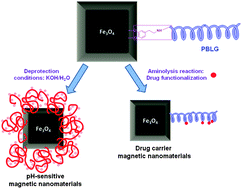Magnetite and maghemite are of particular interest is their use in the biomedical area, especially for applications related to targeted drug delivery, immunoassays, biomacromolecule purification, clinical diagnosis and therapy, such as magnetic resonance imaging (MRI), and magnetic fluid hyperthermia (MFH). For biomedical applications, the surface of the magnetite nanoparticles needs to be suitably engineered to acquire improved colloidal stability in physiological media (avoiding agglomeration), biocompatibility, drug encapsulation ability, and specific target ability to ensure desirable interactions with cells or tissues.
Having that in mind, the study of Marcelo and co-workers presents the synthesis of hybrid magnetic–polypeptide nanoparticles using a novel approach; that is the combination of dopamine employed as a bioinspired adhesive for a hydrophobic magnetite surface, acting at the same time as an initiator of the ring opening polymerization of g-benzyl-L-glutamate N-carboxyanhydride. Further deprotection allowed the authors to achieve poly(glutamic acid) chains, leading to pH sensitive hybrid materials. In addition, to explore the potential application of this system for drug carriers, the incorporation of a drug model compound, procaine, was also performed. Therefore, the resulting novel hybrid magnetite–polypeptide materials could be considered as good candidates for biomedical applications, such as contrast agents for magnetic resonance imaging, hyperthermia and drug delivery.
Hybrid materials achieved by polypeptide grafted magnetite nanoparticles through a dopamine biomimetic surface anchored initiator by G. Marcelo, A. Muñoz-Bonilla, J. Rodríguez-Hernández and M. Fernández-García, Polym. Chem., 2013, 4, 558-567.
Julien Nicolas is a guest web-writer for Polymer Chemistry. He currently works at Univ. Paris-Sud (FR) as a CNRS researcher.











